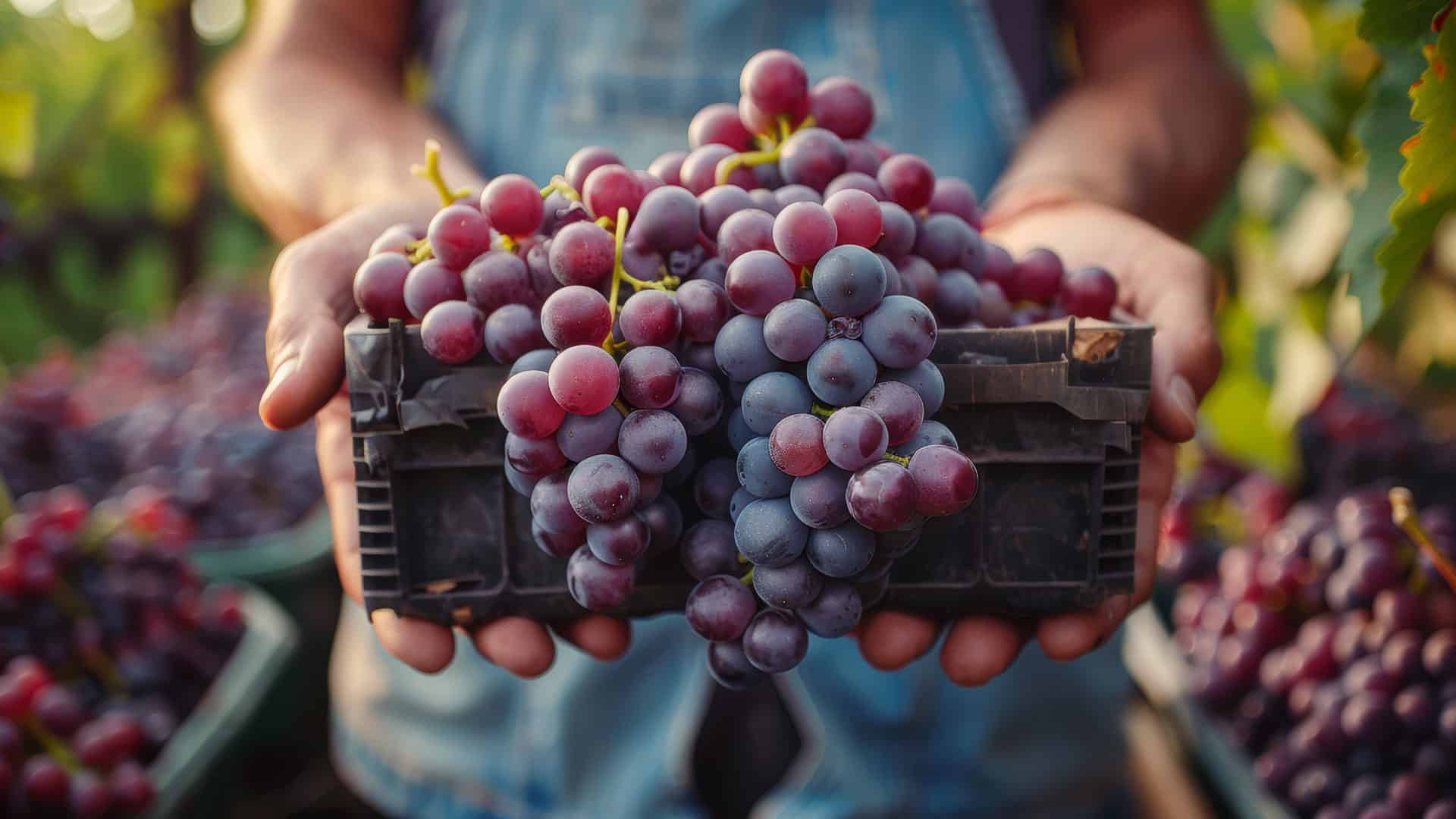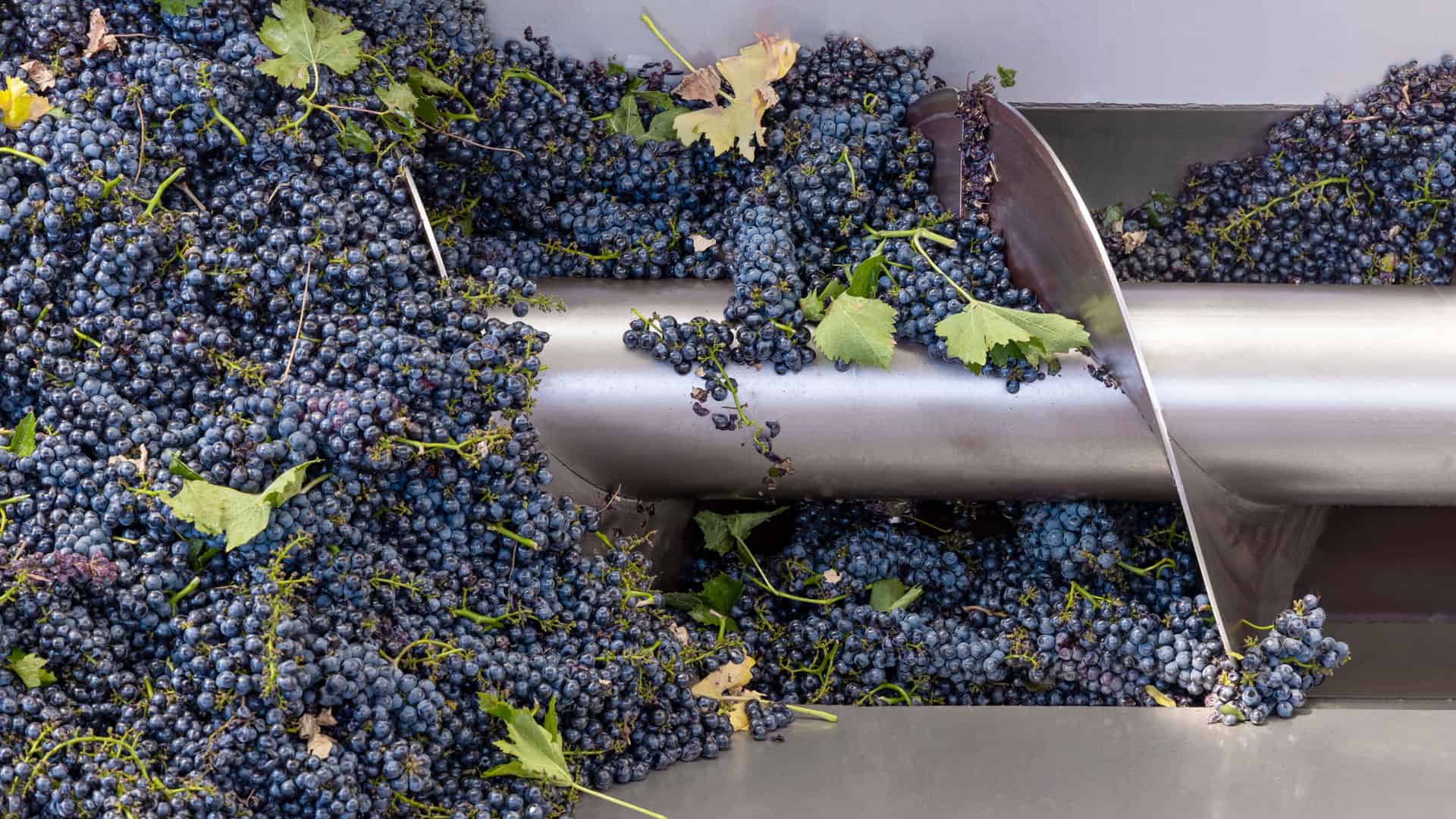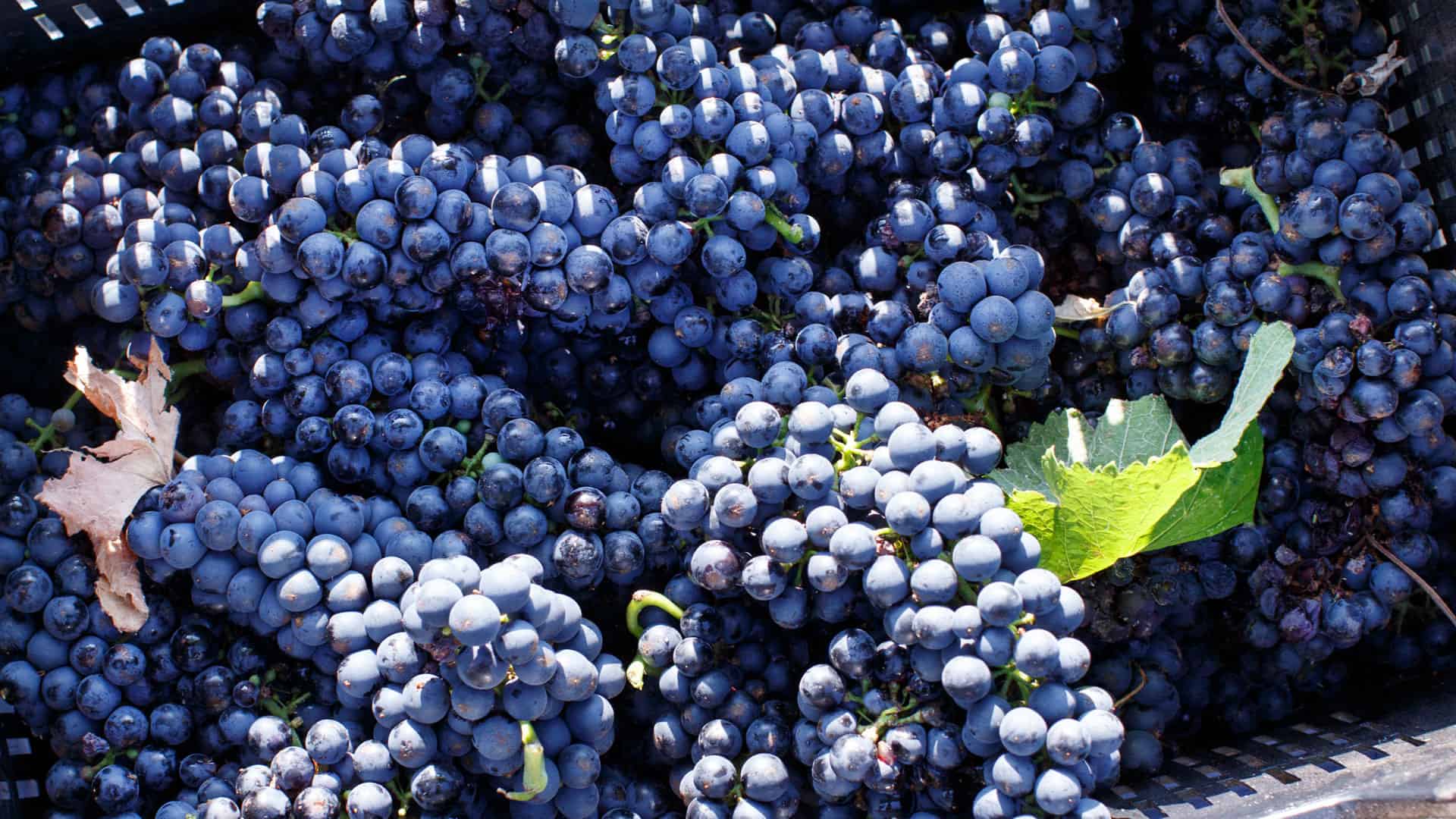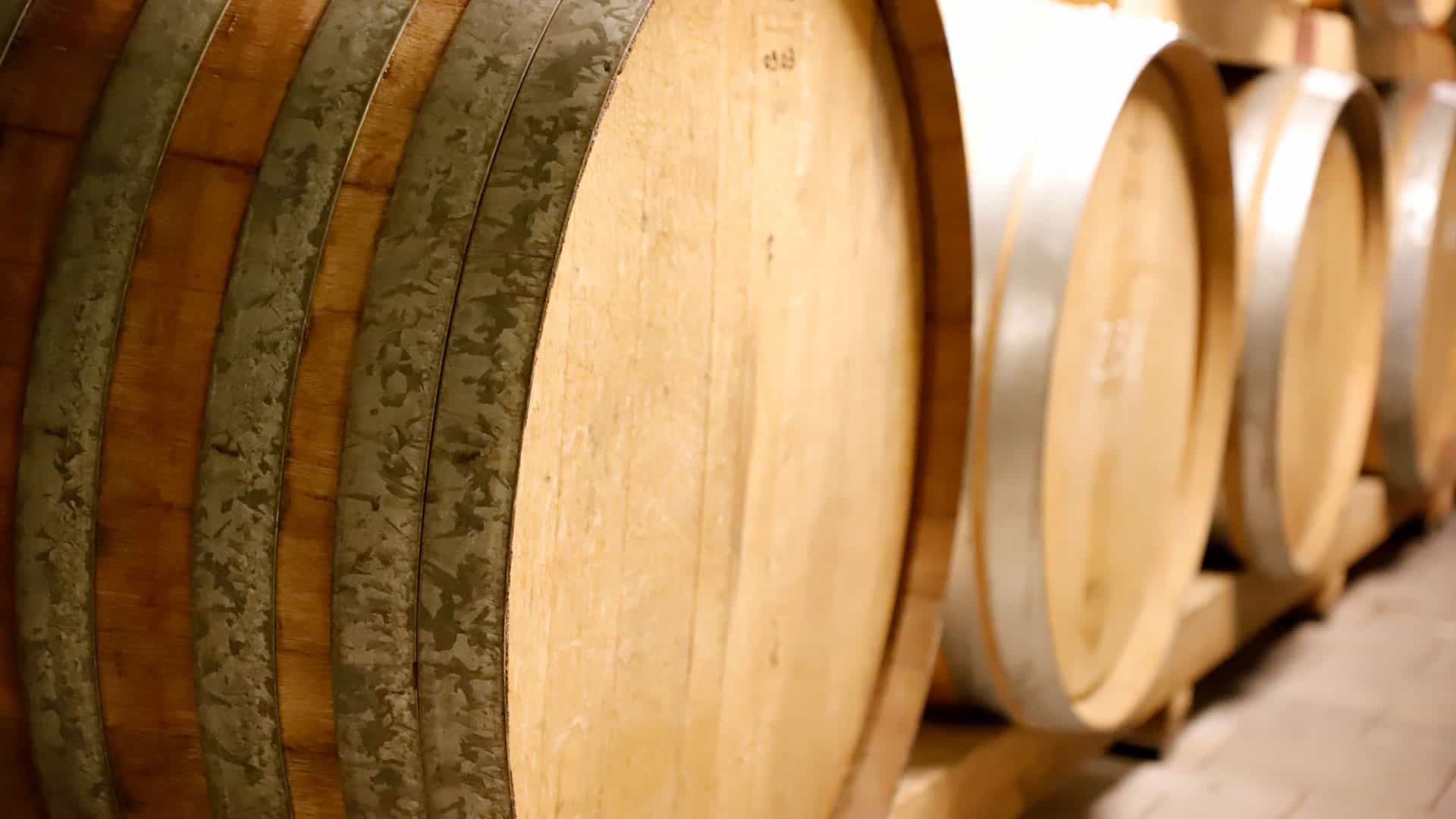The production of red wine
The winemaking processes are basically identical for white wine, rosé wine and red wine. However, the order of the processes varies. While white wine is pressed immediately after crushing, this process only takes place after fermentation for red wine (and also for rosé wine).

As with white wine, after destemming – i.e. the automatic removal of stems and crests – the grapes are first crushed for red wine production. This breaks open the grape skins and a first part of the grape juice is extracted. This is followed by the alcoholic fermentation process, which is triggered by the natural yeast present on the grape skins or by the addition of cultured yeast. The yeast converts the sugar in the grape juice, producing alcohol and gaseous carbon dioxide, which escapes. The fermentation of red wines takes place at a temperature of 20° to 32° C. As a rule, alcoholic fermentation ends automatically when the yeast has consumed all the sugar in the grape juice. In this case, one speaks of a dry or dry-aged wine. The final alcohol content of most dry wines is between 11.5% vol. and 16% vol. There are various options for making a medium-sweet or sweet wine, which are described in the blog “Making white wine”.

Red or dark grapes are essential for the production of red wine. The skins of these grapes must also be fermented so that the colorants and tannins they contain can be extracted. The heat generated by the yeast during fermentation supports this extraction process. However, this alone is not enough to make the red wine red, as the grape skins float on the fermenting grape juice and form a thick layer, also known as the grape cap. If this cap is not broken open, hardly any colorants and tannins can be extracted from its interior. For this reason, the grape skins must be frequently and carefully mixed with the fermenting liquid. This is usually done by submerging the skins and pressing them into the liquid with a mash tamper. Another widely used method is pumping over, in which the liquid is pumped up from the bottom of the fermentation tank with a hose and sprayed over the cap from above. The maceration time for red wines is usually between one and five weeks.

The grapes are then pressed in a wine press. The term “pressing” comes from Latin and means “to tread with the feet”. This custom is of course no longer common today. Instead, the mash is pressed in a wine press, i.e. the sweet must is gently separated from the solid components in order to prevent grape seeds, for example, from being crushed and releasing their unwanted bitter substances into the must. After pressing, the must is filled into suitable containers, usually tasteless stainless steel tanks. Depending on the grape variety, fermentation in wooden barrels is also possible. Fermentation is triggered by natural yeast or by the addition of cultured yeast. This takes place at a temperature of 12° to 22° C and usually lasts six to eight days for white wine. The lower the temperature during fermentation, the fruitier the aromas in the wine.

After alcoholic fermentation is complete, almost all red wines undergo a second fermentation, malolactic fermentation. This is not initiated by yeast, but by bacteria. They convert the tartaric or malic acid contained in the wine into the milder lactic acid. However, the resulting buttery flavors are virtually imperceptible due to the structure of the red wine. The skins and dead yeast are then removed from the red wine, which is then pressed. Depending on the grape variety and the future wine characteristics desired by the winemaker, it is then bottled in the respective containers, usually in tasteless stainless steel tanks or in wooden/barrique barrels. The storage time in the containers usually lasts up to a year, sometimes even just a few months. If the wines are stored for longer, the term maturing is often used. Over time, the aromas develop from primary to tertiary, and structural components such as tannins become better integrated. Maturation takes place in oak barrels, which give the wine its own, so-called secondary aromas, before the wines are finally bottled and sold.

FAQ:
Why is the temperature higher when fermenting red wine than when fermenting white wine?
The fermentation temperature for red wine is usually higher than for white wine because the grapes from which red wine is made usually require a longer period of time on the skins to extract color, aromas and tannins from the skins. A higher temperature accelerates the extraction process in the production of red wine by increasing the activity of the yeast and supporting the breakdown of the color and aroma substances from the grape skins. White wine, on the other hand, is often fermented at cooler temperatures to allow the process of slower extraction of color and tannins and to preserve the freshness and fruitiness of the berries.
What is meant by the term mash in winemaking?
In the production of wine, mash refers to the mixture of crushed or crushed grapes, including the skins, seeds and juice. This process typically takes place after the harvest during the production of wine, especially in the production of red wine, where the mash remains in contact with the juice during fermentation to extract color, aromas and tannins from the skins.
When should the winegrower start harvesting the grapes for wine production?
The winemaker should start harvesting the grapes for the production of wine when the grapes are ripe. This means that the juice of the grapes contains enough sugar to be converted into alcohol during fermentation. The ratio of sugar to juice gives the so-called Oechsle degree. At the same time, the winemaker must ensure that not all the acid has been broken down in the grape. If the proportion of acidity is too low, the wine will later appear too mild and clumsy in the glass. This is why a balanced ratio of acidity and sugar in the grape juice at the time of harvest is very important for the production of white wine and for wines in general.
What do the colors white and red tell us about wine?
Basically, the colors white and red say something about whether it is a white wine or a red wine. However, the color of a wine tells the wine connoisseur much more about the wine, especially since white is not the same as white and red is not the same as red. The color white is available in different color variations for white wine, and the same applies to the color red for red wine. In the world of wine, there are a total of thirty different color nuances, eleven variants for white wine, nine for rosé wine and ten for red wine. You can read all about the colors white, red and rosé and why they say something about age, terroir, vinification and climate in our blog “Now it’s getting colorful”.
What is an important step in the winemaker’s work when making red wine?
An important step for the winemaker in the production of red wine is the grape harvest, where the berries are picked by hand or by machine. After the harvest, the next step is destemming, where the berries are separated from their stems. This is followed by fermentation on the skins, where the grapes are crushed and the juice is fermented with the skins to produce alcohol thanks to the yeast. The mash fermentation is followed by the pressing step, in which the wine is separated from the solid components. Finally, the wine is placed in barrels, also known as wooden barrels, for ageing, which is another important step in the winemaking process.
What influence does the ageing of wine in oak barrels, also known as wood, have on the acidity of red wine?
The ageing of wine in oak barrels can have a remarkable influence on the acidity in red wine. During the barrel ageing process, acidity tends to be reduced as contact with the wood softens certain acid components. This process requires a delicate touch on the part of the winemaker to achieve the desired acidity while extracting the aromas from the oak. During fermentation, sugars in the berries are converted into alcohol, which also influences the acidity. The production of red wine in oak barrels, also known as wood, therefore requires precise control over the fermentation process to keep the acidity at an appropriate level while developing the characteristic oak aromas. Experienced winemakers understand the complex interactions between fermentation, maturation in oak barrels and acidity development and adapt their techniques accordingly to produce a balanced and high-quality wine.
Why does the standing time on the mash in the production of red wines differ from the standing time in the production of rosé?
The time spent on the skins varies between the production of red wines and rosé wines due to the different production methods. In the production of red wines, the longer time on the skins is a crucial step in the winemaker’s work, as it helps to extract color, tannins and aromas from the skins. This intensive work is crucial for red wines to develop their characteristic depth and complexity. In contrast, the production of rosé wines requires a shorter time on the skins to extract only a limited amount of color and tannins. This specific way of working aims to produce a rosé with a delicate color and a fresh taste, adjusting the maceration time accordingly.
What are the individual important steps in the production of red wine?
The production of red wine is a complex and fascinating type of work that involves several important steps. The winemaking process begins with the harvest, during which the ripe grapes are carefully picked by hand or by machine. This harvest is a crucial step that significantly influences the quality of the resulting wine. The harvest is followed by crushing, where the berries are crushed to release the juice. This step is crucial for the extraction of color, tannins and aromas from the berry skins. Fermentation is another important part of the winemaking process, where the yeasts convert the sugar into alcohol to create the wine. Wood plays an important role during fermentation, as many red wines are aged in wooden barrels to develop their aromas and texture. The winemaker’s work during this part of the process is crucial as they take control of the temperature, duration and other parameters of fermentation. Winemaking is an art that requires a great deal of experience and dedication to create a product of the highest quality. Each step in this complex process is an integral part of creating a unique and appealing wine. The time spent on the skins varies between the production of red wines, white wines and rosé wines due to the different production methods. In the production of red wines, the longer time on the skins is a crucial step in the winemaker’s work, as it helps to extract color, tannins and aromas from the skins. This intensive work is crucial for red wines to develop their characteristic depth and complexity. In contrast, the production of white wine and rosé wine requires a shorter time on the skins to extract only a limited amount of color and tannins. This specific way of working with rosé aims to produce a rosé with a delicate color and a fresh taste, adjusting the maceration time accordingly.

